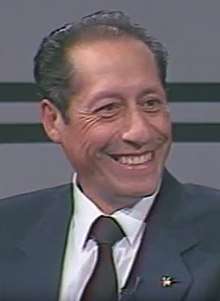Guido Vildoso
General Guido Hernán Vildoso Calderón (born 5 April 1937, La Paz, Bolivia) is a former officer in the Military of Bolivia and de facto President of Bolivia in 1982.
Guido Vildoso | |
|---|---|
 Vildoso in 1991 | |
| President of Bolivia | |
| In office 21 July 1982 – 10 October 1982 | |
| Preceded by | Celso Torrelio |
| Succeeded by | Hernán Siles |
| Personal details | |
| Born | Guido Hernán Vildoso Calderón 5 April 1937 La Paz, Bolivia |
| Nationality | Bolivian |
| Political party | None |
| Profession | Military |
Biography
Born in La Paz, Vildoso joined the Bolivian armed forces and took specialized courses in Brazil, Panama, and the United States. In the 1970s he served in the cabinet of military dictator General Hugo Banzer. Vildoso was second in command in the Bolivian Army when, in July 1982, he was entrusted by his peers with the task of extricating the military from power and returning the country to constitutional, democratic rule. His appointment followed the debacle of the highly unpopular 1980-82 dictatorships of generals Luis García Meza (1980–81) and Celso Torrelio (1981–82).
Faced with a grave social, economic and fiscal crisis, Vildoso accelerated the re-democratization process. He and his fellow commanders essentially had two options: call new elections, or to reconvene the 1980 Congress and respect the results of that year's presidential contest. When it became apparent that the country would crumble into civil war before new elections could be held, Vildoso's junta recalled the 1980 Congress and promised to accept its choice of president. Congress reconvened on 23 September, and almost its first act was to reconfirm the 1980 election results, which showed former president Hernán Siles well ahead, though short of a majority. On 5 October, Congress overwhelmingly elected Siles as president.
Vildoso returned the presidential emblems to Congress on October 10, 1982, thus closing the door on military control of Bolivia. This gesture allowed Siles to formally take office later that day. Nonetheless, Vildoso and his cabinet were loudly booed by the population present at the transfer of power to Siles. The Bolivian Congress did later acknowledge Vildoso for his two main accomplishments: restoring democracy to Bolivia with no bloodshed and developing the fundamentals of the economic plan, 21060, that was later used by Víctor Paz Estenssoro to restore sound macroeconomic variables to the nation.
After Presidency
After the handover of authority, Vildoso retired from the military and currently lives in Cochabamba, Bolivia. He is reportedly highly regarded by Bolivian citizens. To date, he is the last non-constitutional ruler in his country.
References
- Prado Salmón, Gral. Gary. "Poder y Fuerzas Armadas, 1949-1982."
| Political offices | ||
|---|---|---|
| Preceded by Celso Torrelio |
President of Bolivia 1982 |
Succeeded by Hernán Siles |